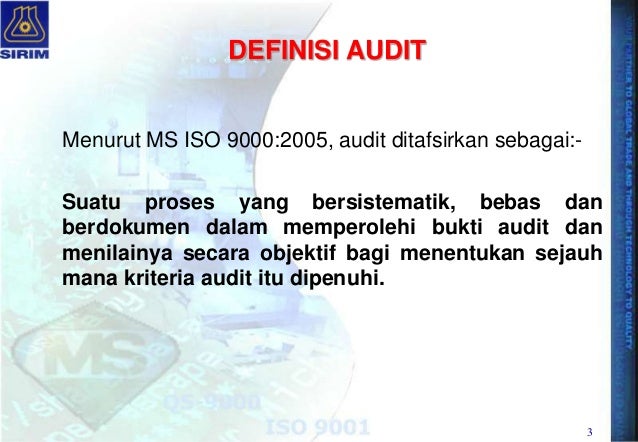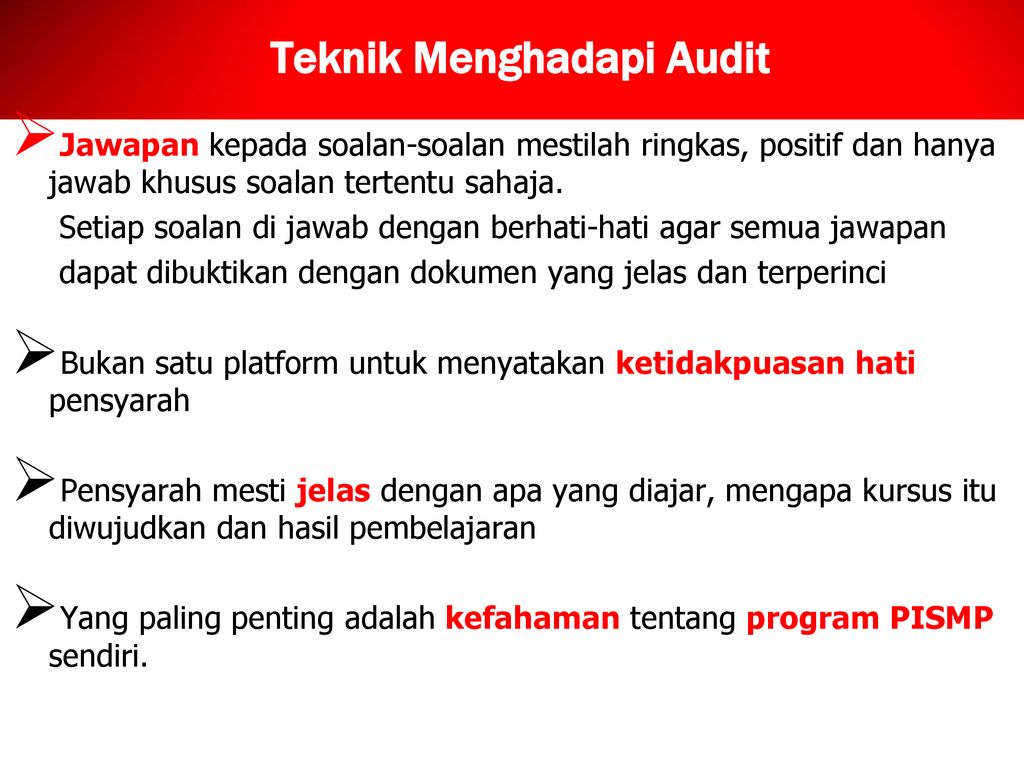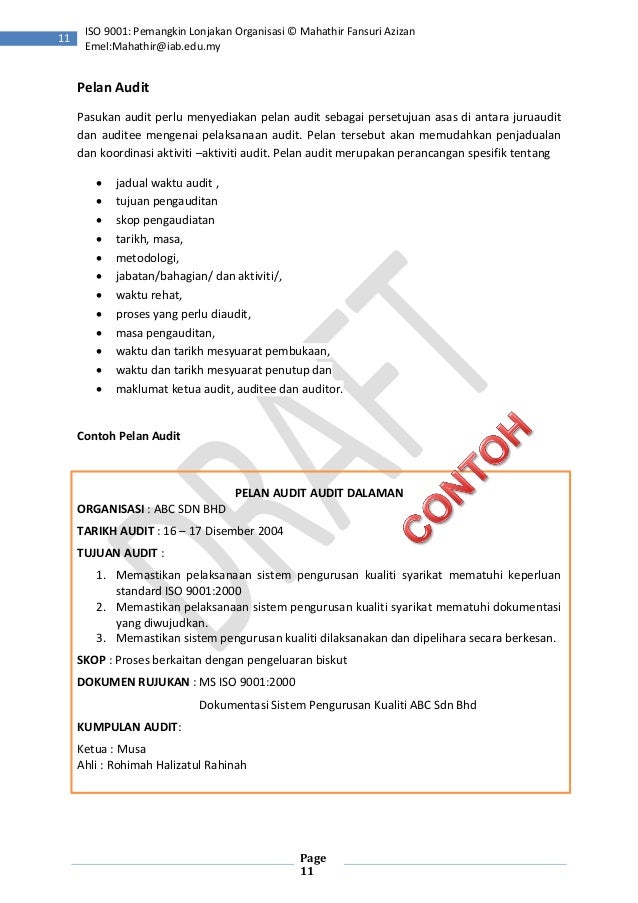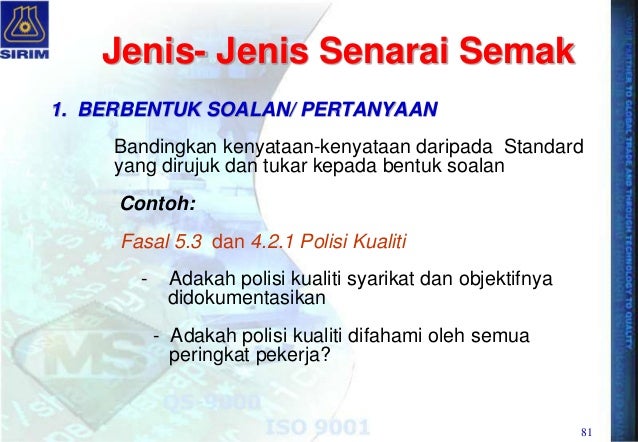Menulis laporan audit iso 9001 14001 ohsas 18001 bukanlah hal yang sulit baik malam ini saya akan sharing bagaimana membuat laporan audit yang baik. Wijaya i5 kebayoran baru jakarta 12170. Contoh checklist audit no item audit item evaluasi catatan auditor. Contoh Soalan Audit Iso 9001 IMS (ISO 9001, ISO 14001, and ISO 45001) Internal Auditor Training Programme All the management systems like quality, environment, and occupational health and safety are all unified by the concept of risk.
General Requirements
- Where are the processes needed for the quality management system identified?
- Have the sequence and interaction of the processes been determined?
- What criteria and methods will be used for operation and control of the processes?
Management
- Where are the processes needed for the quality management system identified?
- Have the sequence and interaction of the processes been determined?
- What criteria and methods will be used for operation and control of the processes?
- How does management ensure that customer needs and expectations are determined, converted into requirements and fulfilled?
- Does this include customer obligations related to the product-including regulatory?
- Does the quality policy include a commitment to continual improvement?
- Does it provide a framework for establishing and reviewing objectives?
- Do the quality objectives include a commitment to continual improvement?
- Do quality objectives include those needed to meet requirements for product?
- How does the management rep promote customer awareness?
- Does the quality manual include a description of the sequence and interaction of the processes included in the quality management system?
- Does Management Review consider changes that could affect the quality system?
- Are there records of the output of management review? Do they include:
actions to improve the quality system and its processes
improvement of product related to customer requirements
Resources
- Can the organization demonstrate that resources are provided to address customer satisfaction?
- Are they provided in a timely manner?

Human Resources
- Has the organization evaluated the effectiveness of training provided?
- Has the organization ensured that its employees are aware of the relevance and importance of their activities and how they contribute to achievement of the quality objectives?
Planning
- Has the organization planned for realization of product?
- Does it include product quality objectives?
- Does it include the need to establish processes and documentation, provide resources and facilities specific to the product?
- Does the plan for measurement and monitoring to ensure conformity and achieve improvement identify the need for and use of statistics?

Customer Requirements
Does the identification of customer requirements include product requirements not specified by the customer, but necessary for the intended or specified use
obligations related to product, including regulatory and legal requirements
Review of product requirements
Contoh Soalan Audit Iso 9001 Audit
Does the organization confirm customer requirements when the customer does not provide a documented statement of requirement?
Customer Communication
Has the organization identified and implemented arrangements for communication with customers relating to:
- product information inquiries
- contracts or order handling including amendments
- customer feedback including complaints
Purchasing Control
How has the organization determined the extent of control of purchasing processes?
Is it dependent on the effect on subsequent realization processes and their output?
Customer Property
Has the organization applied the care of customer supplied property to intellectual property?
Internal Audit Iso
Preservation of Product
Has the organization validated any process where resulting output cannot be verified?
Does verification include:
- qualification of process
- qualification of equipment and personnel use of defined methodologies and procedures requirements
- for records revalidation
Customer Satisfaction
- Is the organization monitoring information on customer satisfaction and dissatisfaction?
- Where are the methodologies for obtaining and using this information defined?
- Has the organization analyzed appropriate data to determine:
- suitability and effectiveness of the quality management system
- actions to improve the quality system and its processes
- improvement of product related to customer requirements

Latihan Profesionalisme dalam bidang Pengurusan Strategik dan Pengurusan Kualiti:Latihan Luar Negara:i. Strategic Management & Leadership Skills: World Trade Institute, New York, USA (1996)ii. Quality (TQM) in Education: SEAMEO Innotech, Manila (1998)iii. Strategic Planning in Education: University of York, England (2000- 2004)iv. Strategy Performance Measurement Systems: U of Adelaide, Australia (2005)C. Mempunyai sijil profesional Juruaudit (Lead Auditor) ISO 9000 sejak 1997 dan Sijil Kejurulatihan MSISO 9000 dari MAMPU.Berpengalaman menjadi juruaudit bersama dengan MAMPU serta memberi konsultasi dalampembinaan dokumen kualiti dan Audit Kualiti Dalaman.D.
Portal rasmi Institut Teknikal Jepun Malaysia atau dikenali sebagai JMTi.Ia merupakan sebuah Institut Kemahiran Tinggi yang berada dibawah Kementerian Sumber Manusia(KSM). MS ISO 9001: 2015 – Quality Management Systems. Print MS ISO 9001-CT. Scope of standards? Quality Management Systems (QMS) What does certify to the standard means? An organisation has established a systematic approach to instill quality by ensuring that their products meet customer requirements. This does not mean that the. INTERNAL QUALITY AUDIT CHECK LIST Management Representative ISO 9001:2008Auditee Auditor Audit. Documents Similar To Contoh Audit Internal Check List (ISO 9001. Audit dalam ms iso 1. 1 SESI 1 PENGENALAN DAN KEPENTINGAN AUDIT DALAMAN 2. 2 PENGENALAN Kriteria Audit Bukti Audit Penemuan Audit Kepatuhan Ketidakpatuhan Major ObsMinor Kesimpulan Audit Persijilan Re-Audit Skop Audit Audit Kriteria Auditor 3.
Kursus audit kualiti dalaman iso 9001 2008 • 1. 1KURSUS AUDIT KUALITIDALAMANMS ISO 9001:2008olehMuhamad Bustaman b. Abdul Manaf(Pensyarah Cemerlang DG 54)Institut Aminuddin Baki, KPM/mbustaman@iab.edu.mymbustaman@iab.edu.my • Taklimat Kursus• Pengenalan Diri • Jadual Kursus danKandungan Kursus• Peraturan SemasaBerkursusmbustaman/IAB/KPM/102 • mbustaman/IAB/KPM/103BIODATAFASILITATORMUHAMAD BUSTAMAN BIN HAJI ABDUL MANAFPensyarah Cemerlang DG 54, Instutut Aminuddin Baki, KPMA. Pengalaman: Pengurus kursus Pengurusan Strategik dan Pengurusan Kualiti di Institut AminuddinBaki semenjak 1995.1. Pengurusan Kualiti dalam pendidikan 2. Perancangan StrategikB.
Windows 3.1 video driver. Manfaat pensijilan •.
Audit Iso 9001
Kitaran pensijilan? Proses dan kitaran pensijilan Bagaimana membuat permohonan? Senarai badan pensijilanyang diiktiraf oleh Jabatan Standard Malaysia boleh diakses melalui URL yang berikut * URL mungkin berubah dari semasa ke semasa. Sila rujuk semula laman web Jabatan Standard Malaysia di jika URL tidak berfungsi. Manfaat pensijilan •.
Dalam mengejar persyaratan dokumen ISO 9001:2015, banyak perusahaan/organisasi yang berfokus pada membuat banyak dokumen yang dianggap berkaitan dengan Sistem Manajemen Mutu, seringkali dokumen yang telah dibuat ternyata tidak masuk dalam persyaratan yang ditetapkan dalam ISO 9001:2015. Untuk menghindari hal tersebut, ISO Center Indonesia akan menyebutkan dokumen & rekaman wajib apa saja yang dibutuhkan untuk memenuhi persyaratan dalam klausul ISO 9001:2015. Selain persyaratan wajib, ISO Center juga akan menyebutkan dokumen non wajib yang bisa digunakan untuk menunjang implementasi Sistem Manajemen Mutu, yang mana dokumen tersebut lazim digunakan oleh kebanyakan organisasi/perusahaan dalam implementasi ISO 9001:2015.

Pelatihan Internal Audit ISO 9001:2008 di bagian purchasing PT.GTG, setelah pelatihan audit mutu internal, menjelang pelaksanaan eksternal audit. Pelatihan Internal Audit ISO 9001 2008 ini memberikan ketrampilan bagi calon internal auditor PT GTG agar dapat melaksanakan Internal Audit ISO 9001:2008 dengan baik dan Benar, Pelatihan Internal Audit ISO 9001:2008 ini di bimbing oleh fasilitator dari Global Management Indonesia, Setelah diadakan Pelatihan Internal Audit ISO 9001:2008 selama sehari, peserta diminta untuk praktek Live Audit Secara Langsung.
It must retain evidence of audit program implementation and audit results. Internal audit is the one of the important tool required by this standard used to gauge the health of your QMS. How effective is it in meeting ISO 9001, your own QMS, customer and regulatory requirements. You must have a documented procedure for your internal audit process.The scope of your internal audit program must cover the: • Audit of operation processes to determine conformity of both product / services and their processes to customer and applicable regulatory requirements. • Audit of the QMS to determine conformity to the ISO 9001 standard. • Audit of the QMS to determine conformity to organizational requirements. • Audit of QMS processes and their interaction to determine if the QMS has been effectively implemented and maintained.
Organisasi telah mewujudkan pendekatan yang sistematik untuk menerapkan kualiti dengan memastikan produknya memenuhi keperluan pelanggan. Pendekatan ini tidak bermakna produk itu telah mematuhi standard produk, tetapi organisasi tersebut mempunyai satu sistem yang konsisten untuk menghasilkan produk yang memenuhi keperluan pelanggan. Siapakah yang perlu memohon? Mana-mana organisasi tanpa mengira saiz Standard yang digunakan? Standard Kebangsaan • MS ISO 9001:2008 -Sistem Pengurusan Kualiti - Keperluan (SEMAKAN PERTAMA) (ISO 9001:2008, IDT) atau • MS ISO 9001: 2008 - Quality Management Systems - Requirements (FIRST REVISION) (ISO 9001:2008, IDT) atau Standard Antarabangsa • ISO 9001:2008 - Quality Management Systems - Requirements *Standard bagi siri MS ISO 9000 tentang Pengurusan Kualiti juga disediakan untuk rujukan lanjut.
Bidang kepakaran lain: Change Management, Benchmarking, Balanced Scorecard (KPI), StrategicLeadership Skills, Leadership Coaching, Strategic Thinking Skills & Personal Balanced Scorecard.E. Ahli panel Sistem Star Rating KPM 2008 & Ketua Pasukan 2010.F. Timbalan Wakil Pengurusan Ssitem Pengurusan Kualiti MS ISO 9000 IAB.
Iso 9001 Audit Plan Example
Audit criteria may relate to the whole audit program as well as each individual audit. Audit methods refer to the specific techniques that auditors use to gather objective audit evidence that can be evaluated to determine conformity to audit criteria. Examples of audit methods include interview of personnel, observation of activities, review of documents and records, etc. You must define the minimum qualification requirements for internal auditors. These requirements include knowledge of QMS processes and their interaction, related QMS controls, customer requirements, applicable regulatory requirements, the ISO 9001 standard, the audit process and audit techniques. Internal auditors needs to be trained in the ISO 9001 standard as they generally audit for conformity to organizational requirements and also for conformity to ISO 9001 requirements. Additionally, the ISO Guidelines for quality and environmental auditing says that auditors should have knowledge of quality management system standards and their application to the organization.
Aspek – aspek yang saya tanyakan diupayakan dalam kerangka menyeluruh untuk membahas sebuah sistem secara utuh. Seluruh cabang pikiran ini bisa ditanyakan atau hanya sebagian tergantung situasi dan kondisi pada saat audit. Contoh yang diberikan merupakan contoh sederhana ketika kita membahas prosedur penerimaan surat yang memang secara umum selalu ada pada setiap organisasi.
Contoh Soalan Audit Iso 9001 Sample
Are the practices being carried out well? The presence of nonconformities in a department or process may indicate the system is ineffective for those areas. 9.2 Internal Audit 9.2.1 The organization should conduct internal audits at planned intervals to provide information on whether the quality management system conforms to the organization’s own requirements, the requirement of ISO 9001:2015 standards and is effectively implemented and maintained 9.2.2 The organization must plan, establish, implement, and maintain an audit program, which must include frequency, methods, and responsibilities, planning requirements and reporting.
Sila layari untuk mendapatkan standard tersebut. Standard-standard lain bagi siriISO 9000 boleh didapati di. Kitaran pensijilan? Proses dan kitaran pensijilan Bagaimana membuat permohonan? Senarai badan pensijilanyang diiktiraf oleh Jabatan Standard Malaysia boleh diakses melalui URL yang berikut * URL mungkin berubah dari semasa ke semasa. Sila rujuk semula laman web Jabatan Standard Malaysia di jika URL tidak berfungsi.
• mbustaman/IAB/KPM/104 • mbustaman/IAB/KPM/105 • mbustaman/IAB/KPM/106 • mbustaman/IAB/KPM/107 • mbustaman/IAB/KPM/108 • m bustaman/IAB/KPM/10 9OBJEKTIF UTAMA• Untuk melengkapkan pesertadengan pengetahuan dankemahiran yang diperlukan untukmelaksanakan audit kualitidalaman ke atas pelaksanaansistem pengurusan kualiti MS ISO9001:2008 dengan berasaskanStandard Management SystemAuditing ISO.
The Process manager must also report any opportunities for QMS improvement. The Process manager must analyze the results of each audit as well as the annual audit program to determine strengths and weaknesses in QMS processes, interactions, functions, products, etc., to identify and prioritize opportunities for improvement. Audit records include annual audit schedule, audit planning such as criteria, scope, frequency, methods, auditor selection and assignment, etc., auditor competence and training, audit checklists and forms, audit notes and other evidence gathered, audit findings, nonconformity reports, audit reports, corrective actions and follow-up of internal audit nonconformities, analysis of audit program performance indicators and trends, and identified improvement opportunities. Performance indicators should be used to measure the effectiveness of your internal audit process and monitor trends in these indicators, to continually improve your audit program. Performance indicators may include reducing the number of – late or delayed audits, incomplete audits, incomplete audit records and late reports, auditor errors, auditee complaints, and use of untrained auditors, etc. The output of your internal audit program may be used as performance indicators to: • Determine the degree of conformity of the QMS to ISO 9001, customer and regulatory requirements. • Determine the effectiveness of QMS implementation and maintenance.
It must have management support and resources behind it. Audits must be performed in an impartial manner, which requires auditors to have freedom from bias or other influences that could affect their objectivity. For example, having responsibility for the work, or a vested interest or shares in a supplier or third party company they are assigned to audit, would be conflicts of interest. Internal audits must be carried out to a procedure according to requirements given in clause 9.2 of ISO 9001:2015. The procedure must address the responsibilities for conducting the audits, ensuring independence, recording results, and reporting to management. Audits obtain objective evidence of conformity with requirements. The evidence must be based on fact and may be obtained through observation, measurement, test, or by other means. Evaluating the extent to which audit criteria are fulfilled involves an assessment of both implementation and effectiveness. Is the organization practicing what it described in its documentation?
• Determine the degree of conformity of product to contractual and regulatory requirements. • Identify areas of the QMS that need improvement. Audit Objectives Always establish the objectives of the audit. Audit objectives are not limited to the ISO 9001 standard. Clear audit objectives help determine the scope and depth of the audit, as well as, the resources needed.
In determining the time frame for your audit program, you should consider organization size, complexity of product and processes, health of the QMS, customer, registrar and regulatory requirements, etc. The most common time frame is six months. Consider adjusting the audit frequency and perhaps even the audit scope, of specific processes or group of processes, when: • You experience internal or external nonconformities. • Get customer complaints. • Have critical or high risk processes. • Have frequent or significant changes to processes and product. Your internal audit program should consider the following: • Input from audited area and related areas • Key customer oriented processes • Process and product performance results and expectations • Opportunities for continual improvement • Feedback from customers Audit criteria, refers to the specific QMS policies, objectives, ISO requirements, documentation, customer and regulatory requirements, etc., that the audit is referenced to or conducted against.
While making an audit program, consideration must be given to the importance of concerned processes, changes impacting the organization and the results of previous audits. It must define audit criteria and scope for each audit.
ISO 9001:2015 Clause 9.2 Internal Audit Definition: ISO defines audits as “Systematic, independent and documented process for obtaining audit evidence and evaluating it objectively to determine the extent to which audit criteria are fulfilled.” Internal audits, sometimes called first-party audits, are conducted by, or on behalf of, the organization itself for management review and other internal purposes, and may form the basis for an organization’s declaration of conformity. In many cases, particularly in smaller organizations, independence can be demonstrated by the freedom from responsibility for the activity being audited. External audits include those generally termed second- and third-party audits. Second-party audits are conducted by parties having an interest in the organization, such as customers, or by other persons on their behalf. Third-party audits are conducted by external, independent auditing organizations,such as those providing certification/ registration of conformity to ISO 9001 or ISO 14001. When two or more management systems are audited together, this is termed a combined audit. When two or more auditing organizations cooperate to audit a single auditee, this is termed a joint audit. Introduction: An audit is a systematic, independent, and documented process for obtaining audit evidence and evaluating it objectively to determine the extent to which audit criteria are fulfilled. Audits are structured and formal evaluations. The term systematic means the company must plan and document its system for auditing.
Sederhana kan?? Tapi kenapa pada saat mereka bertanya ternyata sering menyusahkan? (setidaknya untuk beberapa orang pertanyaan auditor eksternal cukup memusingkan hehehe) Ini disebabkan karena auditor eksternal telah terlatih untuk mengembangkan daftar pertanyaan sesuai dengan situasi dan kondisi serta respon dari auditeenya. Menanyakan beberapa pertanyaan yang sama berulang-ulang pada orang yang berbeda akan membuat anda kaya dengan segala macam respon yang timbul dari pertanyaan tersebut. Hal ini juga membuat anda terlatih untuk menggali informasi lebih dalam dari salah satu pertanyaan di atas.
Nah terkait dengan pertanyaan audit internal ini, sebagai konsultan saya sering ditanya bagaimana cara membuat pertanyaannya setidaknya yang sesuai dengan tujuan untuk memenuhi persyaratan? Wah klo di tanya seperti ini jawabannya adalah table di atas sayangnya table ini tidak aplikatif saat digunakan untuk audit internal karena keterbatasan kemampuan dan pengalaman auditor internal yang memang tidak di didik untuk menjadi auditor. Jadi saya mencoba menggambarkan pola pikir saya untuk lebih menjelaskan pertanyaan – pertanyaan apa saja yang perlu di pertanyakan pada saat audit internal. Gambar di atas adalah gambar yang memperlihatkan cabang – cabang pola pikir saya saat menyusun pertanyaan untuk audit internal.
Auditor should be Independence. During the audit Auditors should ensure that the objectivity and impartiality of the audit is not compromised. Auditors cannot audit their own work. Auditor independence must be ensured when assigning personnel to specific audits. Process owners must take timely corrective action on nonconformities found in their area. They should use the corrective action procedure to determine root cause, take appropriate action and follow-up to determine if results indicate that the root cause has been eliminated. Audit results must be summarized and reported for management review.